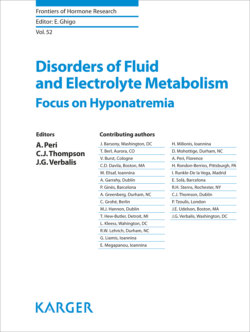Читать книгу Disorders of Fluid and Electrolyte Metabolism - Группа авторов - Страница 31
На сайте Литреса книга снята с продажи.
Pathophysiology of Disorders of Water Homeostasis: Hyponatremia
ОглавлениеHyponatremia is defined by a decrease in the concentration of sodium in plasma.
As is evident from analyzing the above-mentioned Edelman equation (equation 2) this can come about when the ratio of exchangeable cations to total body water is decreased. As depicted in Figure 2, such a decrement in the ratio can occur under the following circumstances [18]:
1. Unchanged total exchangeable body cations with increased total body water (Fig. 2a).
2. Decreased total exchangeable body cations with a smaller decrease in total body water (Fig. 2b).
3. Increased total exchangeable body cations with a larger increase in total body water (Fig. 2c).
4. Decreased total exchangeable body cations with increased total body water (Fig. 2d).
It is important to note that a decrease in total exchangeable potassium (e.g., hypokalemia) per se, even in the absence of significant decrement in total body sodium, can cause hyponatremia. Hypokalemia causes a shift of potassium out of the cell with a commensurate entry of sodium [19]. The reverse occurs during potassium repletion: as potassium chloride increases plasma sodium concentration in the absence of administered sodium [20].
Either an absolute or relative excess of body water is present in every one of the settings leading to hypotonic hyponatremia. As depicted in Figure 3 on the pathophysiology of hyponatremia, free water excess is a proximate step in the disorder. Water excess can develop by:
• Increased free water intake, or
• Decreased renal free water excretion.
